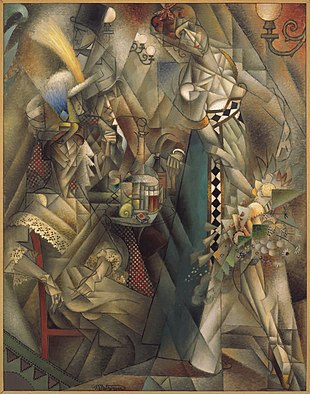Dancer in a café
 |
|
| Artist | Jean Metzinger |
|---|---|
| Year | 1912 |
| Medium | Oil on canvas |
| Dimensions | 146.1 cm × 114.3 cm (57.5 in × 45 in) |
| Location | Albright-Knox Art Gallery. Acquisition: General Purchase Funds, 1957, Buffalo, New York |
Danseuse au café (also known as Dancer in a café or Au Café Concert and Danseuse) is a large oil painting created in 1912 by the French artist and theorist Jean Metzinger (1883–1956). The work was exhibited in Paris at the Salon d'Automne of 1912, entitled Danseuse. The Cubist contribution to the 1912 Salon d'Automne created a controversy in the Municipal Council of Paris, leading to a debate in the Chambre des Députés about the use of public funds to provide the venue for such 'barbaric' art. The Cubists were defended by the Socialist deputy, Marcel Sembat. This painting was realized as Albert Gleizes and Jean Metzinger, in preparation for the Salon de la Section d'Or, published a major defence of Cubism, resulting in the first theoretical essay on the new movement, Du «Cubisme».Danseuse au café was first reproduced in a photograph published in an article entitled Au Salon d'Automne "Les Indépendants" in the French newspaper , 2 Octobre 1912. The painting is now located at the Albright-Knox Art Gallery, Buffalo New York.
Danseuse au café is an oil painting on canvas with dimensions 146.1 x 114.3 cm (57.5 x 45 in). As the title indicates the painting represents a woman dancing in a café. She is shown on the right half of the canvas wearing an elaborate gown and holding in her right hand a bouquet of flowers. In the café scene, four others, two women and two men, can be observed on the left of the painting, three of whom are seated in front of a table upon which various items are placed (including beverages), and one of whom is placed seemingly in the background (upper left).
As in other works by Metzinger of the same period, there are elements to be found of the real world, e.g., lighting fixtures, flowers, feathers and lace. The rest of the canvas consists of a series of crescendos and diminuendos of greater or lesser abstraction, of convex and concave forms, of hyperbolic and spherical surfaces, that stem from the teachings of Georges Seurat and Paul Cézanne. The Divisionist brushwork, mosaic-like 'cubes', present in his Neo-Impressionst phase (circa 1903 through 1907) have returned giving texture and rhythm to vast areas of the canvas, visible both in the figures and background.
...
Wikipedia
